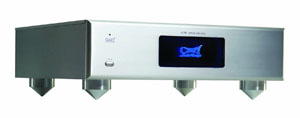 |
|||||||
| |
|
|
|
 |
|
|
|
This is the matching power amplifier to the C306 preamplifier, reviewed In TIE's last issue. The two units were not reviewed together because I believe that each has a place in someone's audio set-up, and not necessarily the same one. Also, I was waiting for a little more technical information from Dennis Had, master of the company he founded many years ago. While the technical stuff is important, I hold that the most consequential element of all electronics is the sound. I'll get to that after I describe the... Appearance The Sound The amp took about a week to fully burn in and settle to its ideal operating condition. This was done simultaneously with the C306 preamplifier, and when I was satisfied that everything was in good working order, I began my serious listening tests using the Elac speakers that I had just reviewed. Expecting to hear a somewhat hard, digital sound, I was taken aback after listening to just a few bars of music. First of all, there are no digital idiosyncrasies or other sonic peculiarities. In fact quite the opposite is true. Dennis Had has managed to introduce some of his signature tube sound to the A306, and that was one heck of a surprise. The Elacs sport an upgraded Heil Airmotion Transformer for the high frequencies and they reacted to the A306 as though they were connected to a good single-ended tube job - amazing! The highs were sweet, smooth and crystal clear demonstrating the amp's ability to resolve ultra high frequencies, perhaps even a touch better than some single-ended tube amps. Upper midrange (from about 2600Hz to about 5000Hz) was a bit bolder than I expect from tube gear, but exhibited impressive detail and resolution all well balanced with upper and lower frequencies. Pure midrange (from about 160Hz to 1300Hz) again blended well with the segments above and below and low and behold there were plenty of harmonics, very much as I'd expect from enticing tubes. With my Ethera Vitaes in the system, the results were similar. Although they aren't as efficient as the Elacs, the A306 was a great match, literally extracting detail and providing precise sound stage dimensions. Also, the Etheras took on body and musical soul that few other amps have provided since I first acquired these loudspeakers. Not to compare, but to investigate the amplifier's reaction to another preamplifier, I connected the Wyetech Labs Opal (an in-house component). As I am intimately acquainted with this preamp's voice, my auditioning session took only about fifteen minutes enough time to ascertain that the A306's sonic accomplishments are correct as described above. My test clearly showed that any good (and neutral-sounding) preamplifier will demonstrate the merits of this powerful amplifier. There is certainly synergy with the (matching) preamplifier, the C306, but don't be concerned if you already have a good one that you like. Synopsis & Commentary In Vol. 17, No. 2, we were unable to include technical details in the review of the Cary Audio Design's C306 solid state balanced preamplifier. We now have the particulars: As with the matching A306 power amplifier, the C306 preamplifier merges digital computer technology and pure analog discrete circuitry. The C306 has four 18dB analog line gain stages two separate gain stages for each channel. One gain stage amplifies the positive phase (+180 degrees) and the other gain stage amplifies the negative phase (-180 degrees). Two stages for each channel equal the four active line circuits. All signals in the audio path are routed through Class A solid-state devices utilizing both FET inputs and low impedance push-pull bipolar output devices. To control the available gain, stepped 0.1% resistors are employed in a relay-controlled ladder attenuated circuit. This stepped individual resistor control circuit is said to provide the most signal purity. The front panel display on the C306 is a Noritake vacuum florescent display with a blue lens. This receives and displays the critical control functions from a 32-bit Motorola CPU inside the unit. The CPU stores all user-selected information including volume level of each selected input, phase polarity and the selected balance setting for each channel. The CPU is the brain controlling the stepped attenuation system. The Motorola processor controls all functions of the preamplifier. On the C306's analog side, there are a total of eight fully regulated power supplies dedicated to each channel's analog circuit as well as multiple power supplies for the alphanumeric, Noritake display, and dual supplies for the Motorola processor. The entire preamplifier is built from precision machined aluminum. All PC boards are multi-sided plated through G-10 glass. Obviously, the rather complex and thoughtfully engineered C306 preamplifier provides the sonic merits referred to in our review in Vol. 17, No. 2, page 26: Nothing in this preamplifier disturbs, nothing gets in the way of the music.
|
|
| News | Reviews | Commentary | Marketplace | Contact Us | Home |
